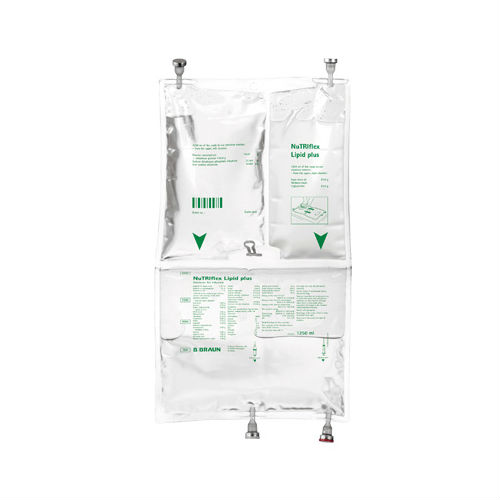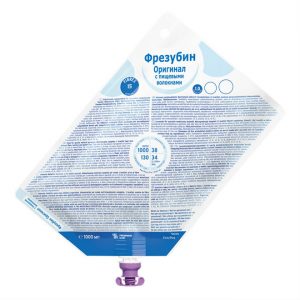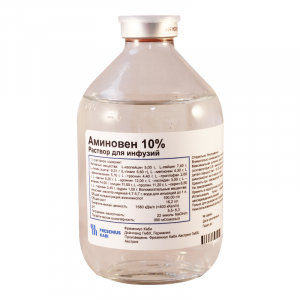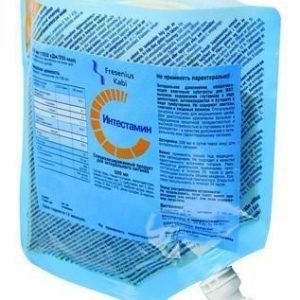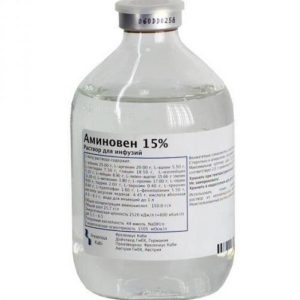Description
Pharmacological action of
Intravenous amino acids administered enter the intravascular and intracellular depots of endogenous free amino acids. The introduction of all amino acids necessary for the synthesis of proteins (including irreplaceable, conditionally interchangeable and interchangeable amino acids) contained in the preparation provides high nutritional efficiency and reduces the burden on the body arising from protein synthesis.
Thus, the main therapeutic effect of Nutriflex 70/240 is to supply the body with a substrate for protein synthesis and energy through glucose during parenteral nutrition.
Individual concentrations of amino acids are selected so that with the intravenous administration of this solution, an increase in the concentration of each amino acid in the plasma does not exceed normal limits, which ensures the maintenance of homeostasis of amino acids in plasma.
Glucose is the most adapted energy carrier for the body and at the specified dose itself or together with an additionally introduced lipid emulsion covers the patient’s needs for non-protein calories, protecting amino acids from inappropriate use.
Indications
Used for parenteral nutrition in inpatient and outpatient settings to cover the daily needs of patients in energy, amino acids, electrolytes and fluids during parenteral nutrition in patients with moderate to severe catabolism in cases where enteral nutrition is impossible, insufficient or contraindicated, and also in combination with it.
The composition is developed for the category of patients who have a limitation in the volume of injected fluid, for example: heart failure parenteral nutrition in acute and chronic renal failure in patients receiving hemodialysis parenteral nutrition in patients with hypercatabolism (burns, neurotrauma, sepsis, etc.).
Contraindications
impaired amino acid metabolism hyperkalemia hyponatremia impaired metabolism (for example, with diabetes mellitus) coma of an unclear etiology hyperglycemia, unadjusted insulin doses up to 6 units. / h acidosis severe hepatic and / or renal failure children under 2 years of age individual intolerance to one of the components of the mixture.
General for parenteral nutrition: severe circulatory disorders (collapse and shock) severe tissue hypoxia hyperhydration disturbances of water-electrolyte balance pulmonary edema decompensated heart failure.
Caution: in patients with increased osmolarity of blood plasma, heart failure, liver and / or renal failure.
Recommended use
Nutriflex 70/240 is intended for insertion into the central veins only. Methods of preparing Nutriflex 70/240 for use: Nutriflex 70/240 is a two-chamber bag, the compartments of which are separated by a special seam.
One chamber is filled with a solution of amino acids and electrolytes, and the other with a solution of glucose and electrolytes. Immediately before starting parenteral administration, solutions of amino acids, glucose and electrolytes should be mixed.
To do this: remove the two-chamber bag from its protective packaging, unfold it and lay it out on a flat surface (on a table), to break the separation seam by pressing with two hands on one of the chambers of the bag, pick up and mix the contents of both chambers, moving the right and left parts of the bag up and down.
After that, the solution is ready to use. At the end of the infusion, the bag is discarded. If necessary, lipid emulsions can be added to Nutriflex 70/240 by introducing them into the finished solution through a special port located on the top of the bag. If you need to add other ingredients to the finished solution, you must use the additional port located below. All ingredients must be added in compliance with aseptic rules and taking into account their compatibility with each other.
Dosages: Selected according to individual needs. The maximum daily dose is 25 ml / kg bw / day, which corresponds to 1. 75 g of amino acids / kg bw / day and 6 g of glucose / kg bw / day. Speed of administration: The maximum infusion rate is 1.4 ml / kg bw / hr, which corresponds to 0.098 g of amino acids / kg bw / h and 0.336 g of glucose / kg bw / h. Duration of use: There are no restrictions on the duration of use of the drug. Precautions for the use of the drug: For patients with cardiac, hepatic and renal failure, the dosage and mode of administration of the drug are set individually.
Special instructions
For complete parenteral nutrition Nutriflex 70/240 should be used in combination with lipid emulsions. The glucose concentration in it is close to the upper limit of its safe level in relation to the body’s ability to efficiently absorb it. Therefore, increasing the caloric content of the mixture is recommended solely due to the introduction of a lipid emulsion into its composition through a special bag port.
Before the start of infusion Nutriflex 70/240, the water-electrolyte balance and the acid-base state of the blood should be adjusted. Too fast administration of the drug can lead to volume overload, disruption of the water-electrolyte balance.
Control over blood sugar is needed. If hyperglycemia occurs, the rate of administration of Nutriflex 70/240 must be reduced or an appropriate dose of insulin should be administered. Intravenous administration of amino acid solutions is accompanied by increased excretion of trace elements in the urine, especially copper and zinc. This must be taken into account when selecting doses of trace elements, especially during long-term therapy. Due to the risk of pseudoagglutination, it is not recommended to use the same infusion systems for the administration of blood products and multicomponent amino acid solutions.
When the drug is administered, regular monitoring of the water-electrolyte balance and the acid-base state of the blood, monitoring of blood sugar concentration, and serum ionograms should be carried out.
During long-term therapy, monitoring of blood counts is necessary (coagulogram, liver function indicators). If necessary, the addition of lnpid emulsions, essential fatty acids, electrolytes, vitamins and trace elements is possible. As with all solutions administered intravenously, strict adherence to aseptic rules is necessary.
Nutriflex 70/240 is a multicomponent solution. When adding other solutions or a lipid emulsion to it, the compatibility of all ingredients must be considered. The drug is supplied in dual plastic containers, designed for single use.
Any unused volumes of the drug cannot be stored and should be discarded. After mixing glucose and amino acid solutions, it is possible to store the drug for up to 7 days at room temperature and up to 14 days when stored in the refrigerator (including the time of drug administration).
Do not use the drug, if the solution is not transparent, there are obvious signs of damage on the bag or its tightness is broken.
Composition
Solution for infusion
(1 chamber – dextrose solution).
1 l dextrose 480 mg
calcium chloride dihydrate 1.2 g
Infusion solution
(2 chamber – solution of amino acids with electrolytes).
1 l alanine 8.49 g
arginine glutamate 8.72 g
aspartic acid 2.63 g
valine 4.54 g
histidine 2.19 g
glycine 2.89 g
glutcid hydrochloride 5 mg 6.11 4g . 48 g
lysine (in the form of a hydrochloride) 3.98 g
magnesium acetate tetrahydrate 1.08 g
methionine 3.42 g
sodium acetate trihydrate 1.63 g
sodium hydroxide 1.14 g
proline 5.95 g
serine 5.25 g srlprnl 3 ppm p 6.15 g
Excipients: water for and.
Side effects
Side effects are very rare. Upon termination of therapy, they are rapidly reversible.
The introduction of the drug can lead to allergic reactions, chills, nausea, and vomiting.
Due to the high osmolarity of the solution, in some cases, signs of increased diuresis may appear.
In such cases, the drug should be discontinued and resumed later at a lower rate of infusion.
In case of side effects that are not described in the instructions, patients should report them to their doctor.
Overdose
With the correct prescription of the drug, an overdose of the drug is not observed
Symptoms of volume overload or overdose of electrolytes: Hypertonic hyperhydration, disturbances of water-electrolyte balance, pulmonary edema.
Symptoms of amino acid overdose: Loss of amino acids in the urine with the development of amino acid imbalance, vomiting, tremor.
Symptoms of glucose overdose: Hyperglycemia, glucosuria, dehydration, serum hyperosmolarity, hyperglycemic or hyperosmolar coma.
Therapy: In cases of symptoms of drug overdose, the solution should be discontinued. Further therapy is selected individually depending on the severity of the symptoms. Infusion may be resumed later at a slower rate with frequent monitoring.
Storage conditions
Out of the reach of children, protected from light at a temperature of no higher than 25 ° C.
Active ingredient
Amino acids for parenteral nutrition, Other preparations Minerals
Conditions of supply of
Pharmacy Prescription
lekarstvennaja form
Ñmulsyya for infusions
